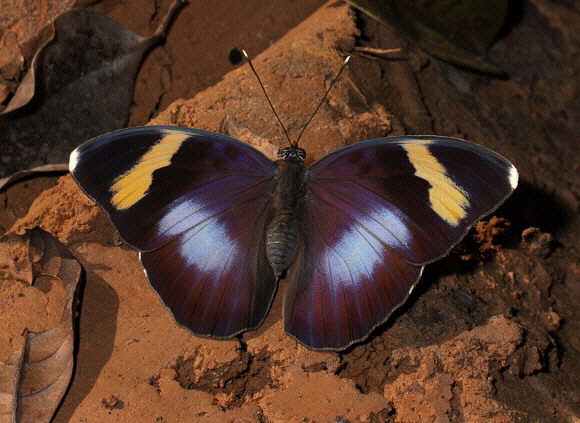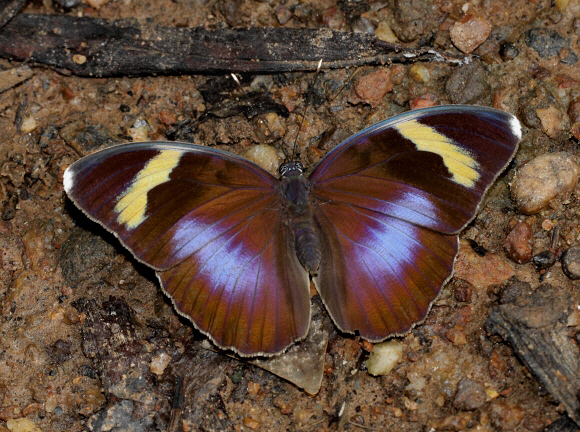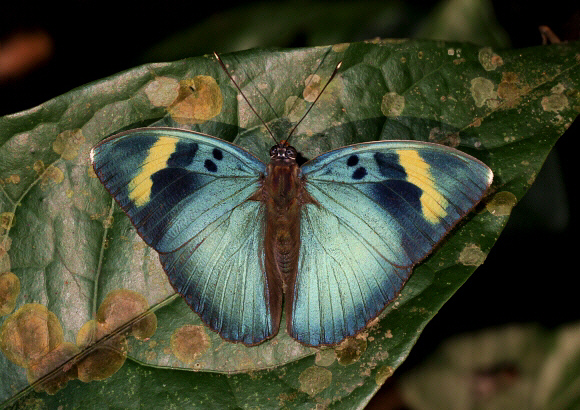
Introduction
The genus Euphaedra comprises of a yet to be discerned number of large and very beautiful forest-dwelling butterflies, all found on the African continent. In 1997 Hecq revised the genus and at that time listed a total of 180 species. This figure is challenged by other workers who believe that many of these are merely local forms or subspecies. However in 2012 Hecq produced a further revision of the eleus species-group, describing an additional 12 species, bringing the total in the genus to 192. When working in the field it is immediately obvious that there are a huge number of specimens that are noticeably dissimilar to any of the insects illustrated by Hecq but it is unclear whether these are examples of intra-specific variation, distinct taxa or hybrids.
All Euphaedra species share a common wing shape. Most have a similar pattern on the upperside – typically the basal areas of the wings ( particularly the hindwings ) have large suffused patches of metallic blue, green, orange or red. Most species also have a cream or orange sub-apical bar. The undersides are usually some shade of yellow or green, marked with black spots and streaks that vary in intensity and configuration according to taxon and locality. Many species including janetta and sarcoptera also have beautiful pink patches or streaks on the underside hindwings.
The female of medon has a wingspan of about 9cms, and is illustrated above. The male is smaller, averaging only 7cms wingspan. It has a metallic olive-green sheen across the wings, and on the forewings has a cream subapical band, and a group of black spots within the discal cell.
Euphaedra medon is the commonest and most widespread species in the genus, found from Gambia to western Kenya and Tanzania.

Habitats
As with all Euphaedra species, this butterfly is an inhabitant of tropical rainforest, and is found at altitudes between sea level and about 1000m. Some species are confined to primary forest, but many including medon are equally abundant in degraded or secondary forest.

Lifecycle
The eggs are laid singly or in clusters of 3 or 4, on the leaves of Allophylus, Deinbollia, Paullinia and Phialodiscus ( Sapindaceae ). They are dome-shaped, and bear a myriad of long spikes.
The caterpillars are adorned with long lateral multi-branched spines which are appressed to the leaf on which they are resting.

Adult behaviour
Both sexes fly close to the ground, elegantly weaving their way through the forest undergrowth. They do so with great adeptness, and are very graceful in flight.
Females, and to a lesser extent males, are strongly attracted to clusters of fallen fruits, particularly Ficus, and patrol back and forth along forest paths in search of them. It is not unusual for groups of up to 30 Euphaedra and Bebearia butterflies of various species to aggregate at such feeding sites.
Both sexes are often seen basking with wings outspread, either in sunspots on the forest floor, or on the foliage of bushes in light gaps. Females sometimes fan their wings slowly open and closed when feeding.
Despite the vividly coloured undersides of many species, Euphaedra are remarkably difficult to see when at rest on the forest floor, among yellowing leaf litter.

